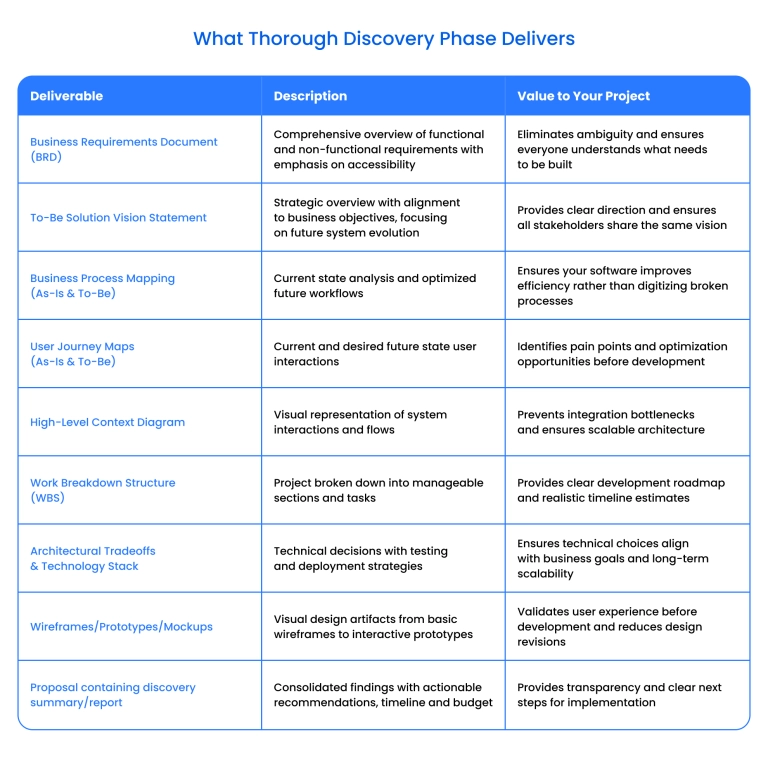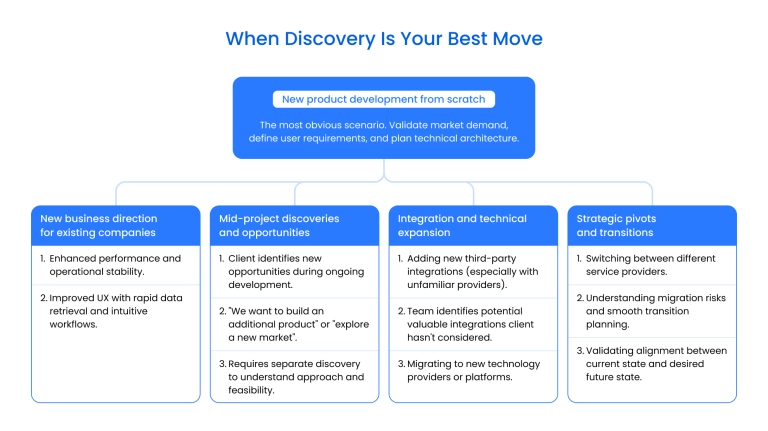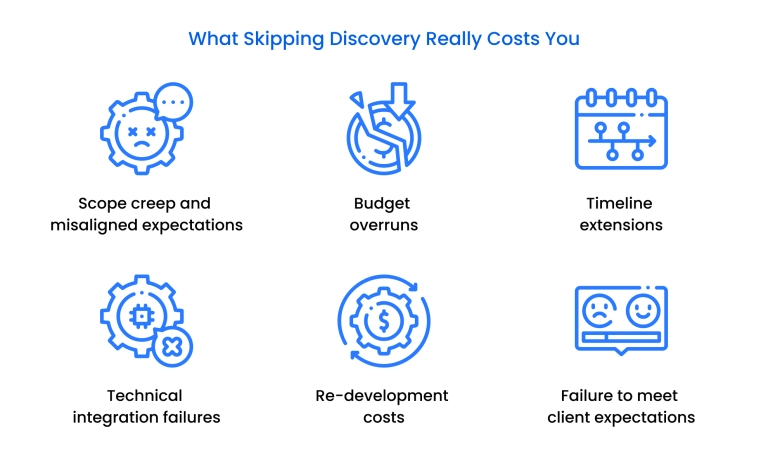You have a brilliant software idea.
It could be a revolutionary healthcare platform, a game-changing fintech solution, or an innovative e-commerce system. The possibilities feel endless.
But here's the reality check: 65% of software projects fail to be delivered on time and within budget. Why? One of the most common reasons is that teams jump straight into development without proper planning.
Why discovery makes or breaks your project
The discovery phase for software development is your project's lifeline – the difference between building something users actually want and burning through your budget on features nobody needs.
"We won't sugarcoat it – skipping discovery can be compared to building a house without blueprints. You might get something that stands, but there's a pretty good chance it won't be what you envisioned" explains Antonina Homoniuk, Delivery Manager at Binariks.
When done right, discovery transforms vague ideas into concrete plans, reduces development risks by up to 70%, and protects you against costly mistakes, scope creep, and product failure.
For this guide, we spoke with Antonina Homoniuk , whose team at Binariks has shepherded multiple software projects from initial concept to successful launch. Her insights will guide you through every aspect of making the discovery phase your competitive advantage.
What is a discovery phase?
The discovery phase is the initial stage of a software development project where we dig deep into understanding what we're actually building and why.
At Binariks, we define it as the stage where your business vision meets technical expertise, focusing on:
- Getting to know your end users
- Understanding their needs and problems;
- Defining the underlying requirements and potential solution options
During this software development discovery phase, teams research, collect, and analyze project information to check if your solution concept is viable, feasible, and usable – three critical factors that determine project success.
Our discovery phase serves one critical purpose: eliminate uncertainty before you spend your development budget.
You want to know exactly what you're building, who you're building it for, and how much it will cost before investing in full-scale development. This stage typically lasts 1-2 weeks, depending on project complexity, and involves intensive collaboration between business stakeholders and the development team.
Why is the discovery phase critical in SDLC?
Here's the hard truth: most software projects that skip the discovery phase in SDLC end up over budget, behind schedule, or completely fail to meet user needs. The discovery phase isn't just important – it's absolutely critical for project success.
When you skip discovery, you're essentially flying blind. You might think you know what your users want, but without proper research and validation, you're building on assumptions. These assumptions become expensive mistakes when you realize halfway through development that you've been solving the wrong problem.
The discovery phase helps you avoid these common project killers:
- Endless scope creep: Without clear scope and requirements, projects typically exceed their original expectations by 200-300%. A lack of measurable expected results leads to constant project extensions, delaying release dates and inflating budgets.
- Disconnected user flows: Important pieces of functionality may be missed and detected late in the development process. This leads to costly revisions and frustrated users who can't complete their tasks efficiently.
- Failure to meet client expectations: Misunderstandings at the initial stage lead to confusion later, wasting both time and money. The solution may not address the problem in the best possible way.
- Missed deadlines: Without precise project boundaries, development timelines easily stretch out, postponing launches and missing market opportunities.
- Increased costs: Unclear goals and requirements result in constant direction changes, leading to significant cost increases. Our experience shows projects without discovery exceed budgets by an average of 189%.
- Re-development due to overlooked requirements: Legal or business requirements that should form the foundation of your solution's design and architecture get missed, forcing expensive rebuilds.
Our Delivery Manager, Antonina Homoniuk, shares a real example from her experience:
"We've encountered situations where clients prefer to move directly to development – which is completely understandable given business pressures and tight timelines. We're always flexible and work with our clients' preferences, but we've learned some valuable lessons along the way.
Imagine a legacy system rewrite – essentially building from scratch. Massive project with tons of moving parts. Without discovery, we had no clear starting point, no prioritization framework, no understanding of business value or potential risks. We were drowning in complexity.
Here's what people don't realize: when you skip discovery, those critical questions the project discovery phase was supposed to solve don't just disappear.
Your team ends up answering them anyway – but now they're doing it while juggling development tasks, under pressure, in chaos. The discovery work happens regardless, just inefficiently and at a much higher cost.
That case? It dragged on way longer than it could have without skipping the discovery phase in a project. We deeply value our clients' preferences and business needs. However, when we see that discovery could genuinely benefit a project, we strongly recommend it. It's not just better for us – it's better for everyone involved."
The discovery phase in software development is not an expense – it's an investment that saves you time, money, and headaches down the road.
Key goals and deliverables of the discovery phase
When you invest in a discovery phase with Binariks, you're not just paying for planning – you're getting concrete deliverables that guide your entire development process. Here's exactly what you receive:

Additional strategic deliverables
When your project requires deeper market analysis or strategic planning, we also deliver:
- Competitors' SWOT Analysis – Identifies differentiation opportunities
- Personas & User Roles – Ensures user-centered design decisions
- Value Proposition Canvas – Focuses on solving real customer pain points
- Lean Canvas/Business Model Canvas – Validates business model assumptions
- Use Case Diagrams – Visual representations of user-system interactions
As Antonina Homoniuk puts it:
"These discovery phase deliverables aren't just paperwork we file away. Every deliverable from the discovery phase becomes a reference point that guides our entire development process. When developers have questions, when stakeholders want changes, when priorities seem unclear – we always come back to these specifications. This keeps everyone focused on what actually matters instead of chasing every new idea that comes up.
I've seen projects where teams work incredibly hard but in different directions. Discovery deliverables prevent that chaos – they ensure every line of code serves a real purpose."
Main steps of the discovery phase
What happens during the discovery phase at Binariks follows a proven methodology we've refined through dozens of successful projects. Our approach ensures nothing gets overlooked while keeping the process efficient and focused.
Antonina Homoniuk explains Binariks' evolved approach:
"We've recently somewhat transformed how we handle discovery. Before, we'd collect everything first – workshops, stakeholder interviews, questionnaires – and only then start working. Different stakeholders would outline different priorities, and the process dragged on.
Now we push to identify the top priority use cases early, even if it's just one or two, and immediately dive deep into those. We're not waiting to gather every possible detail before taking action. The first workshop, identify what's most critical, define a couple of key use cases, and start digging.
We want to understand the client's real pain points quickly and start addressing them while they're as relevant as possible. Broader discovery continues in parallel, but the priority use case is already moving forward – analyzed, estimated, maybe even in development.
Besides, it's worth remembering that discovery isn't just a front-loaded phase. It can happen during the project too, especially when new scope or directions emerge."
Here's how our methodology works in practice:
1. Requirements & Goal Alignment
What we do:
- Define SMART (Specific, Measurable, Achievable, Relevant, Time-bound) goals and objectives
- Communicate problem statement, initial expectations, and success criteria during project kick-off
- Analyze existing documentation, processes, and systems to understand current environment
- Review technical environments, compliance requirements, and project constraints
2. Market & competitive intelligence
What we do:
- Conduct comprehensive competitor SWOT analysis when market insights are required
- Examine industry trends, market conditions, and competitive positioning
- Identify differentiation opportunities and market capture areas
3. User research & role definition
What we do:
- Create detailed personas representing your target audience with specific roles
- Define user roles and permissions aligned with organizational security policies
- Ensure alignment with business processes and multi-tenant architecture requirements
4. Process optimization (As-Is to To-Be)
What we do:
- Document current business processes (As-Is) to confirm accurate representation
- Identify optimization opportunities and design improved future workflows (To-Be)
- Conduct detailed user tasks analysis to understand current interactions and pain points
- Create user journey maps showing current vs. ideal user interactions
5. Technical architecture planning
What we do:
- Evaluate technology environment and assess scalability, maintainability, and performance requirements
- Explore third-party platforms, frameworks, and their associated benefits and risks
- Create high-level context diagrams showing system interactions
- Define technical architecture supporting current needs and future growth
- Consider integration requirements, compliance needs, and preferred technology stack
6. Design validation & prototyping
What we do:
- Create wireframes, prototypes, and mockups for concept validation
- Allow stakeholders to experience solution concepts and provide feedback
- Identify potential issues early and confirm approach meets expectations
7. Risk management & project planning
What we do:
- Identify potential technical, business, and operational risks
- Develop specific mitigation strategies to address challenges proactively
- Create RAID (Risks, Assumptions, Issues, Dependencies) log for ongoing tracking
- Provide detailed estimates for development effort, timeline, and costs based on Work Breakdown Structure
- Break down project into manageable sections with transparent resource allocation
8. Documentation & knowledge transfer
What we do:
- Compile all discovery findings into comprehensive technical documentation
- Create Business Requirements Document, technical specifications, and architecture diagrams
- Provide implementation recommendations and ensure knowledge transfer
- Establish Organizational Process Assets for future project phases
Who is involved in the discovery process
The discovery phase success depends heavily on having the right team members involved. At Binariks, our discovery team is a cross-functional group responsible for understanding and defining user and stakeholder needs while developing solutions that meet those requirements.
- Business Analyst (BA):
Plays a crucial role by acting as the bridge between your business requirements and technical implementation. They facilitate stakeholder interviews, document requirements, conduct user tasks analysis, and ensure nothing gets lost in translation. Our BAs are responsible for creating the Business Requirements Document, user personas, and business process mapping.
- Solution Architect:
Establishes technical requirements by evaluating technology environments and assessing scalability, maintainability, and performance needs. They explore third-party platforms, frameworks, and associated benefits and risks. Our architects create system architecture diagrams, define technology stacks, and ensure technical decisions align with business goals.
- Tech Leads/Senior Engineers:
Support our Solution Architects in conducting technical discovery activities. They provide specialized expertise for frontend, backend, mobile, or specific technology domains. All technical artifacts require validation by our Solution Architect to ensure quality and consistency.
- UX/UI Designer:
Ensures user experience corresponds to your project goals. They create wireframes, user journey maps, prototypes, and mockups. Our designers focus on making your software intuitive and user-friendly while aligning with business objectives.
- Project Manager/Delivery Manager:
Orchestrates the entire discovery process, manages timelines, and ensures all deliverables are completed on schedule. They facilitate communication between team members, organize meetings, track progress using success criteria, and ensure the project stays within scope and budget.
- Client Representative:
Active engagement from at least one representative from your side is highly recommended. This individual should possess comprehensive knowledge of your product requirements and objectives, optimizing the efficiency of our discovery process.
We may also involve specialized experts like security professionals, DevOps engineers, or domain experts depending on your project's specific requirements. Our team structure adapts to ensure you get the right expertise for your unique situation.
When to start the discovery phase

Key insight from our approach: Discovery doesn't always follow rigid SDLC phases. It can run parallel to development when teams need to research new business streams while core development continues.
Antonina Homoniuk adds:
"We often frame mid-project research as "additional planning phases" rather than formal discovery, but when clients want to explore entirely new directions, we recommend dedicated discovery to ensure their vision aligns with what's technically and business-wise achievable."
Common mistakes when skipping discovery
When you skip the discovery phase, you're setting your project up for several quite predictable failures.
Antonina Homoniuk explains:
"When we skip discovery, we only talk about what the client wants without analyzing what currently exists. This creates a disconnect between the current state and what we need to build – that's your scope creep right there.
Without a proper As-Is to To-Be analysis, there are no clear shared expectations about what should be in scope. No upfront risk identification that we could have mitigated early. And of course, costs increase because development takes longer when you're figuring things out as you go.
Meanwhile, competitors don't sleep. Someone else might capture your niche while you're dealing with even a one-month delay because you didn't define some of the project's critical business values upfront. It's always better to know than not to know – without discovery, you usually have zero clarity about what might emerge later."

Antonina Homoniuk concludes:
"Look, 'we'll figure it out as we go' might work fine for simple internal tools. But on complex projects? That's asking for trouble. Discovery isn't something you push through to get to the 'real work' – it IS the real work. It's what prevents all those predictable disasters companies see happen over and over again."
Final thoughts
The discovery phase for software development isn't just another checkbox – it's your method for transforming ideas into successful software solutions. Skip discovery, and you're not saving time or money; you're postponing inevitable problems until they become expensive crises.
The numbers don't lie
Every hour spent in research potentially saves 10 hours in development. Every assumption you validate prevents costly revisions. Every risk you identify early protects your budget and timeline.
At Binariks, we've proven this across dozens of successful projects with companies ranging from startups validating their first product idea to established enterprises modernizing legacy systems.
Why choose Binariks for your discovery phase?
Our approach goes beyond problem identification – we provide actionable recommendations with clear implementation paths. Our cross-functional team of experienced Business Analysts, Solution Architects, and UX Designers ensures every aspect gets attention: business requirements, technical architecture, and user experience design.
We work with founders and companies who want software that actually succeeds. That means starting with solid foundations through our proven discovery phase process refined over years of experience.
Your software project deserves better than guesswork. It deserves the clarity and strategic planning that only proper discovery provides.
Ready to start your discovery phase?
Contact Binariks today and let's transform your software vision into a concrete plan for success. Our team is ready to guide you through every step of the process, ensuring stakeholders stay aligned and your final product is something users love.
Share


